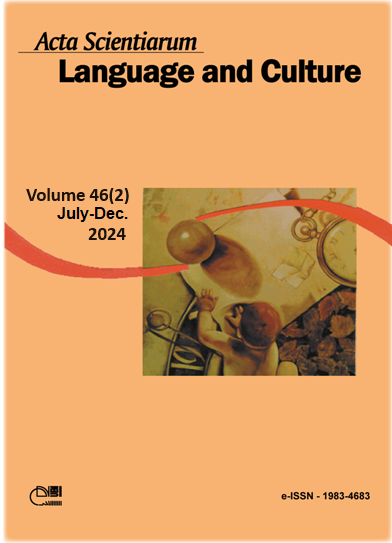The medieval world in cordel: the judeo-christian myth of the Wandering Jew in the popular poetry of Manoel Pereira Sobrinho
Abstract
The Wandering Jew myth dates back to the Middle Ages and spread through orality and writing, always with the meaning of hatred of Jews. It began to appear recurrently in varied artistic genres, but when it enters the literatura de cordel (chapbooks), it takes on a perspective closer to the medieval one. The relationship of this myth with literatura de cordel permeates this study’s subject, which is a literary-historical reflection with the aim of recognizing the permanence of the Wandering Jew myth and its diffusion in Brazil. The study proposes an analytical-interpretative reading of the work O judeu errante by Manoel Pereira Sobrinho (1958). It was developed at the intersection of literature theory with cultural history guided by the premise that literature can represent the way people thought of the world, themselves, their values, prejudices, fears, etc. Thus, the literary work is a privileged historical source for the understanding of symbolic universe of myth in literary forms, without which its secular permanence and circulation would be uncertain. Similarly to the myth, literatura de cordel dates back to the Middle Ages Iberia and explores themes that have entered the conceptual repertoire incorporated into the Wandering Jew myth since medieval times. This is the case of themes such as usury and deicide, which brings to light the image of wandering of the character in Brazilian literature. Such literature is inscribed in the production of poets from the northeast of Brazil with a representation of the Wandering Jew shaping the building of the cordelista’s imaginary: popular culture and aesthetic-thematic tradition. Therefore, the poem analyzes in this study is engendered as a significant element of a nationality: the culture, the memory and the identity of a people.
Downloads
References
Referências
Bauman, Z. (2017). Estranhos à nossa porta. Rio de Janeiro, RJ: J. Zahar.
Braga, T. (2014). As lendas cristãs. Lisboa, PT: Vercial.
Brugger, W. (1987). Dicionário de filosofia: organizado com a colaboração do corpo docente do Colégio Berchmans de Pullach, Munique e de outros professores. São Paulo, SP: EPU.
Carneiro, M. L. T. (2014). Dez mitos sobre os judeus. Cotia, SP: Ateliê Editorial.
Cascudo, L. C. (2000). Dicionário do folclore brasileiro. Rio de Janeiro, RJ: Global.
Delumeau, J. (2009). História do medo no ocidente. São Paulo, SP: Companhia das Letras.
Doré, G., & Dupont, P. (1983). A lenda do judeu errante. Belo Horizonte, MG: Villa Rica.
Durand, G. (2002). As estruturas antropológicas do imaginário. São Paulo, SP: Martins Fontes.
Escrich, H. P. (1961). O mártir do Gólgota. São Paulo, SP: Paulinas.
Fausto Neto, A. (1979). Cordel e a ideologia da punição. Petrópolis, RJ: Vozes.
Ferreira, J. P. (1979). Cavalaria em cordel: o passo das águas mortas. São Paulo, SP: Hucitec.
Ferreira, J. P. (2000). O judeu errante: a materialidade da lenda. Olhar, 2(3), 24-30.
Haurélio, M. (2010). Breve história da literatura de cordel. São Paulo, SP: Claridade.
Huizinga, J. (2010). O outono da idade média. São Paulo, SP: Cosac Naify.
Igel, R. (2017). O incorrigível judeu errante como figura literária no Brasil. Judaica Latinoamericana, 8(2017), 571-598.
Johnson, P. (1995). História dos judeus. Rio de Janeiro, RJ: Imago.
Lacerenza, G. (2014). As perseguições contra os judeus. In U. Eco (Org.), Idade média: castelos, mercadores e poetas (p. 236-241). Alfragide, PT: Leya.
Le Goff, J. (1986). A bolsa e a vida: economia e religião na idade média. São Paulo, SP: Brasiliense.
Le Goff, J. (2013). Uma longa Idade Média. Rio de Janeiro, RJ: Civilização Brasileira.
Leite, M. R. (1992). Romãozinho, o filho maldito. In Denófrio, D. F. & Silva, V. M. T. (org.). Antologia do conto goiano I: dos anos dez aos sessenta. Goiânia: Cegraf/UFG.
Lopes, G. V.; Ferreira, M. P. et al. (2011-), Cantigas Medievais Galego Portuguesas [base de dados online]. Lisboa: Instituto de Estudos Medievais, FCSH/NOVA. Disponível em: <http://cantigas.fcsh.unl.pt>.
Mello, B. A. A. (2016). Tradições discursivas dos exempla: da Idade Média aos folhetos de cordel. Revista do GELNE, 18(2), 247-275.
Nobre, F. S. (2005). Dicionário brasileiro de literatura de cordel. Rio de Janeiro, RJ: Academia Brasileira de Literatura de Cordel.
Pereira, K. M. A., & Bueno, C. F. (2013). O judeu errante nas Minas Gerais: Carlos Drummond de Andrade em busca de Ahasverus. Arquivo Maaravi, 7(13), 1-12. Recuperado de https://periodicos.ufmg.br/index.php/maaravi/article/view/14193/11374
Pereira, M. A. (1955). A vida do judeu errante. Recife, PE: Folhetaria Luzeiro do Norte.
Pesavento, S. J. (2003). História & história cultural. Belo Horizonte, MG: Autêntica.
Pinto, M., & Serra, Conceição O. B. (2012). Cultura e ontologia no mito da cobra encantada. Manaus, AM: Editora da Universidade Federal do Amazonas.
Proença, I. C. (1976). A ideologia do cordel. Rio de Janeiro, RJ: Imago.
Rouart, M.-F. (2005). O mito do judeu errante. In P. Brunel, Dicionário de mitos literários (p. 665-671). Rio de Janeiro, RJ: José Olympio.
Silva, S. B. (1975). O Judeu Errante. Juazeiro do Norte, CE: Filhas de José Bernardo da Silva.
Sobrinho, M. P. (1958). O judeu errante. São Paulo, SP: Prelúdio.
Tavares Júnior, L. (1980). O mito na literatura de cordel. Rio de Janeiro, RJ: Tempo Brasileiro.
Wendover, R. (2010). Flores historiarum. Charleston, SC: Nabu Press.
Woensel, M. V. (1977). O judeu errante no nordeste. Graphos, 2(4), 114-126.
DECLARATION OF ORIGINALITY AND COPYRIGHTS
I Declare that current article is original and has not been submitted for publication, in part or in whole, to any other national or international journal.
The copyrights belong exclusively to the authors. Published content is licensed under Creative Commons Attribution 4.0 (CC BY 4.0) guidelines, which allows sharing (copy and distribution of the material in any medium or format) and adaptation (remix, transform, and build upon the material) for any purpose, even commercially, under the terms of attribution.
Read this link for further information on how to use CC BY 4.0 properly.




















6.png)









